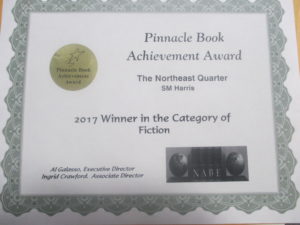In Iowa the economy of each particular year is a reflection of that year’s harvest. Some years are good; some are bad. At the moment 2016 doesn’t seem to have the makings of a good year.
I was reading an article in The Des Moines Register by Kevin Hardy and Donnelle Eller entitled “Is Iowa Heading For A Recession?” which explores this subject.
It is a truism that if there is an economic downturn one year, there will always be a rebounding of the economy a few years down the line. For many farmers the downturns can be particularly painful. It’s their livelihood. And since Hardy and Eller’s article is dated February 10th of this year, this year’s story is not over. There is still a strong possibility of a recession in 2016.
What is different about this year? For one thing, on first glance there are examples which make
 In August The Northeast Quarter won The Pinnacle Book Achievement Award 2017 Best Book Category Fiction. Wherever my mother is right now, I am sure she is throwing one hell of a party.
In August The Northeast Quarter won The Pinnacle Book Achievement Award 2017 Best Book Category Fiction. Wherever my mother is right now, I am sure she is throwing one hell of a party.